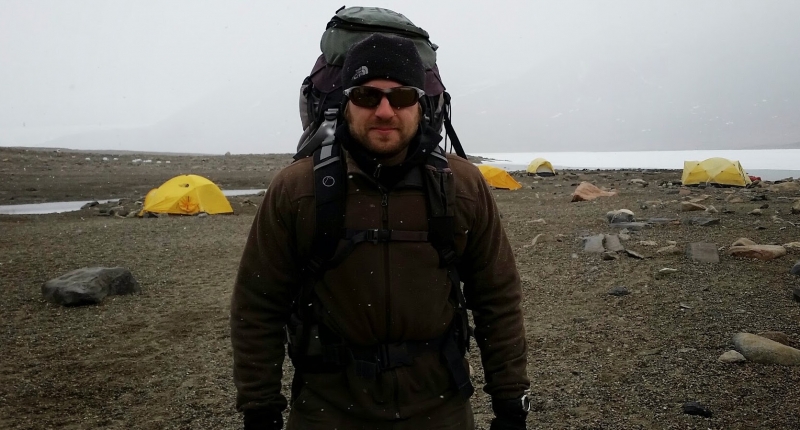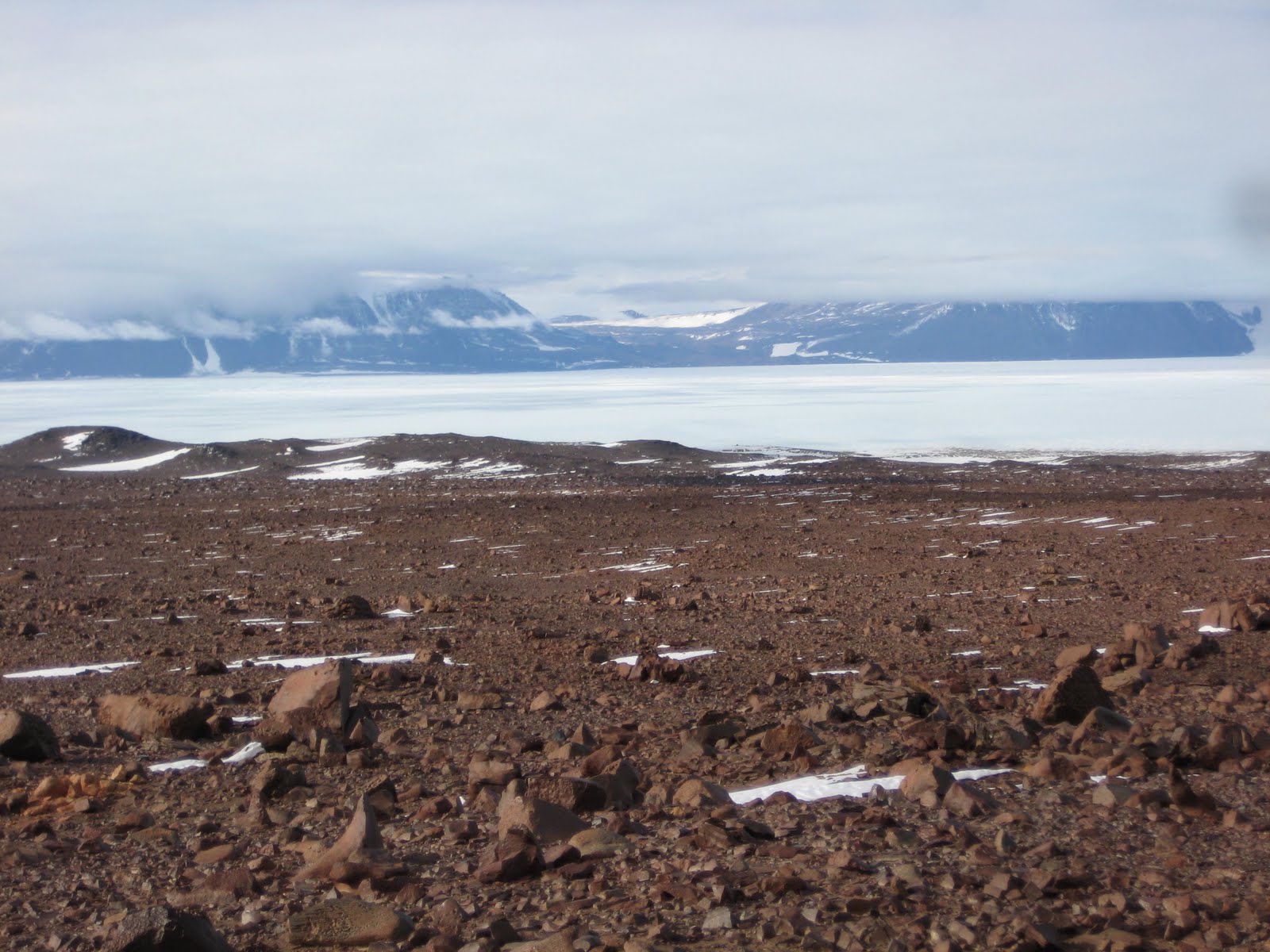NCEAS Portrait: Eric Sokol Wants to Foster Community through the Study of Metacommunities

As a Michigan native, Eric Sokol seems to really like cold places. His work and travels have taken him to Alaska, Antarctica, Colorado, and Idaho. He is drawn to cold places because of the adventure they promise. To him, they tend to be more remote, extreme, and interesting – that, or traveling to cold places is just something people from Michigan do (his words).
Sokol is a quantitative ecologist for the National Ecological Observatory Network (NEON) and the lead principal investigator for the Long-Term Ecological Research (LTER) Network’s Metacommunities Synthesis working group. His work focuses on metacommunities, or groups of ecological communities that are connected by the dispersal of interacting species, in freshwater and polar ecosystems. Sokol’s research involves collecting data from diverse ecosystems, as well as using computer models to simulate and predict how the assembly of metacommunities is linked to patterns in biodiversity.
Sokol is also a talented coder. He developed the Metacommunity Simulation package (MCSim) for the R statistical language, which is used to test hypotheses about how metacommunities can impact local and ecosystem-scale biodiversity.
For this month’s Portrait, we got to know more about Sokol and his exciting research.
How did you get into quantitative ecology?
Sokol: When I was in high school, I really enjoyed math and computer programming, but I didn’t want to become a software developer. It turned out that background gave me an important foundation for my work in graduate school and today in my LTER and NEON work.
In some ways, my story is similar to a lot of other ecologists. I had a formative experience when I was 17, working with the Student Conservation Association. I spent the summer conducting alpine meadow restoration work in the Frank Church River of No Return Wilderness, in Idaho.
After that, I knew I wanted to study nature for my career, but I wanted to do it with a purpose. In college, after a summer of taking field courses at University of Michigan’s Biological Station and working in a stream ecology lab, I became hooked on freshwater stream ecology, particularly stream insects.
How did you first get involved in synthesis work?
Sokol: My first foray into synthesis work was during my graduate program at Virginia Tech. I was doing field work for the Coweeta LTER site on aquatic insect communities in the Southern Appalachians. Because of the rich history of aquatic ecology at Coweeta, I realized I could gather a much more comprehensive dataset by combining my own data from Coweeta with data that were collected from previous studies.
What kind of an impact do you hope your LTER research will have?
Sokol: I hope our working group will provide information on how the assembly and interactions between metacommunities can be used to understand biodiversity stability. In doing so, we hope to provide some guidance about the types of situations when metacommunity assembly can predict ecosystem stability, resistance, and resilience.
I also hope to foster a sense of community, inclusiveness, and collaboration among ecologists who are asking similar questions about biodiversity across the LTER network.
Have you ever had an “ah-ha” moment that has changed the way you think about or approach your work?
Sokol: When I was first learning how to use the R statistical software, I spent two whole days creating code to do matrix multiplication. Later, I found out that R can do matrix multiplication with a single line of existing code. From then on, I learned to check online first to see if R can do something before trying to reinvent the wheel.
What do you value most about your experience working with the LTER network?
Sokol: I most value the collaborators and friends I’ve met, which are not at all mutually exclusive groups! It’s great to have a network of friends and colleagues whom I can call on for career advice, ask a question about a specific data set, ask where to find information about a given field method, or get advice on raising a 14-month-old!
What keeps you inspired outside of work?
Sokol: My 14-month old son is a little scientist who is discovering all the time and inspiring me to continue being curious. I’m also inspired by the Front Range mountains, near our home in Boulder, Colorado. My wife and I take our son hiking and exploring as often as possible, which is not nearly often enough given his age.
I also love playing music. I’ve found that many quantitative ecologists play mandolin, which is something I picked up while living in Blacksburg, VA. I’ve also played drums in various bands. My son seems interested in both instruments. However, at his current age, every instrument is a percussion instrument.

You’ve visited some pretty interesting places to collect data. What was one of your favorite places to visit?
Sokol: The most amazing place I’ve visited was the Meyer Desert in Antarctica. The Meyer Desert is one of the oldest surfaces on earth and is one of the most alien and beautiful places I’ve ever seen. The ground is a Martian red and is littered with wind-sculpted ventifacts. As our field crew hiked up onto a ridge, we had an amazing view of the Beardmore Glacier and its network of hazardous crevasses. This is the same glacier that Shackleton and Scott traversed on foot over a century earlier!
You also have an internet blog called Biologists in Antarctica. How did you get into blogging?
Sokol: Before I left on my first trip to Antarctica, my mom, who was a vice principal, told her teachers and students about my trip. They were really interested in my day-to-day life in the field. I started the blog so I’d have a convenient platform for taking questions, posting responses, and showing pictures.
It was really fun to get questions from kids ranging from second grade to seventh grade. The most common question I got was where did I go to the bathroom. It was also really nice to get a pile of mail while I was in Antarctica. Sometimes one can feel pretty isolated down there, and it really changed my perspective getting pieces of mail from kids who were genuinely curious about what I was doing.
And the blog is still going strong! While I haven’t been to Antarctica in two years, I've maintained contacts with teachers, and my colleagues – who still travel to Antarctica – continue to answer questions and post photos on the blog.
###
Alexandra Jamis was a Science Communications Fellow for the 2017-2018 school year.
NCEAS Portraits feature the people behind our work and impact.
